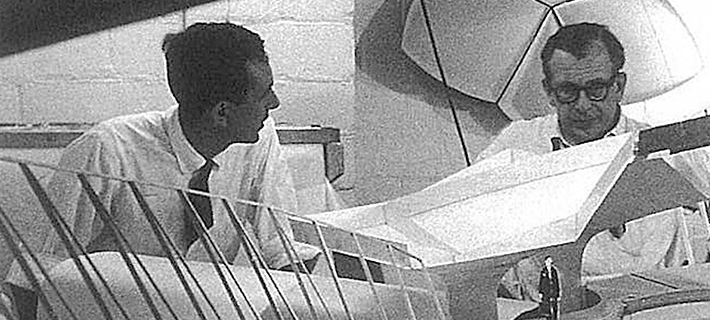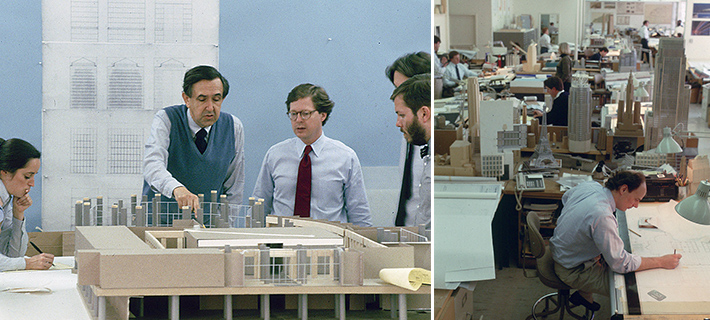“Design on response” and “good architecture”
Pelli:
“The most important lesson I learned during my seven years at Eero’s office was ‘avoidance of style.’ Eero could, like many other famous architects, have established his hallmark style, applying it everywhere, but he didn’t. Eero considered requirements to be different from project to project, and believed that each project warranted its own best solution, an idea I thoroughly agree with. This to me seems self-evident, but is supported by very few architects even today.”
A design naturally shaped by responding to the various elements of a project must be the apotheosis of what you call “design on response.”
Pelli:
Many people argue that like a painter or sculptor, an architect should have his or her distinctive style, but I do not necessarily think so. A painter has complete freedom to express whatever he likes on his blank canvas. But architecture cannot be devised on a blank canvas. We have the site, budget, functional requirements, and above all, the client, users, neighbors, and numerous other conditions to consider. The misguided idea that we do not need to consider these aspects has caused serious damage to cities all over the world. Buildings are more important than architects, and cities are more important than buildings.
To me a “good building” is almost synonymous with a “good architect.” They both serve the place. A good building serves a place, enhancing it with its presence. A good building is high quality, high functioning, and good-looking. But aesthetic appeal is not the priority for me. Architecture should be part of the city. Architecture architecture contributes to a city only when it becomes a part of it.


From left to right Cesar Pelli and Eero Saarinen
Paying respect to what is already there
What is your favorite city in the world?
Pelli:
As far as my travels are concerned, Kyoto, Japan and Venice, Italy are the two most beautiful cities in my view. The two are definitely among my top cities. Kyoto I like for its many shrines and temples, more than the city itself. It is amazing how exquisite works of art exist in great numbers across the town.
What kind of approach do you think we need when building new or doing a development project in a historical town like Kyoto?
Pelli:
Important above all is the sense of reverence because what a historical town already has is the accumulation of centuries of human sensibilities and skills. For example, Kyoto’s temples and shrines originate in religious concepts. But those of us alive today cannot replicate the sensibilities, worldviews, and ideas of the people who made them. In a historical town, we must pay profound respect to everything that is already in it. This applies to any historical town.
When we visit wonderful cities like Kyoto and Venice, we all notice that our behavior changes. This change in human behavior is brought about by what is accumulated in the city over long periods of time. It is therefore essential to consider the place, and the age we live in when building or developing. This kind of deep thinking, along with the respect for what is already there, connects and forms a deeper relationship between the city and the new building or development project. And this relationship constitutes the future shape of the city, affecting the families and future generations that inhabit it.
Kindness and sympathy for others
Tell us about the design processes at your office.
Pelli:
We always begin by identifying problems. For a new office block in a business district, for instance, we first make a scale model of the neighborhood, and place an approximate model of the new building on site, in order to gauge how it affects its surroundings, and how surrounding buildings affect the new building. We then propose three or four completely different solutions, such as a tower and a courtyard.
Sometimes we also invite clients to participate in the design process. Clients have been involved in the project for years by the time we come on board, so their involvement in the design process, if undertaken with care and attention, will ultimately lead to the solution of all problems. It is also critically important to review, upon completion of the project, the outcome and impact of the building or development.
Your client may be the one who planned the building, for example, but a building is more often used on a daily basis not by the client but by the people who work there, or their visitors, isn’t it, necessitating that the architect understand the client as well as the real client behind the client?
Pelli:
Of course. That is a question of kindness. Important across all processes of architectural design is kindness, or your responsibility as a person for your entire conduct, which may be called kindness and sympathy for others.


Cesar Pelli & Associate Office(1980)
Contact
当協会に関するお問い合わせはこちらからお気軽にどうぞ。
お問い合わせ頂いた内容や記入にあたっての個人情報
などは、
お問い合わせ内容に関してのみ利用させて頂き、
それ以外の目的には一切利用致しません。
